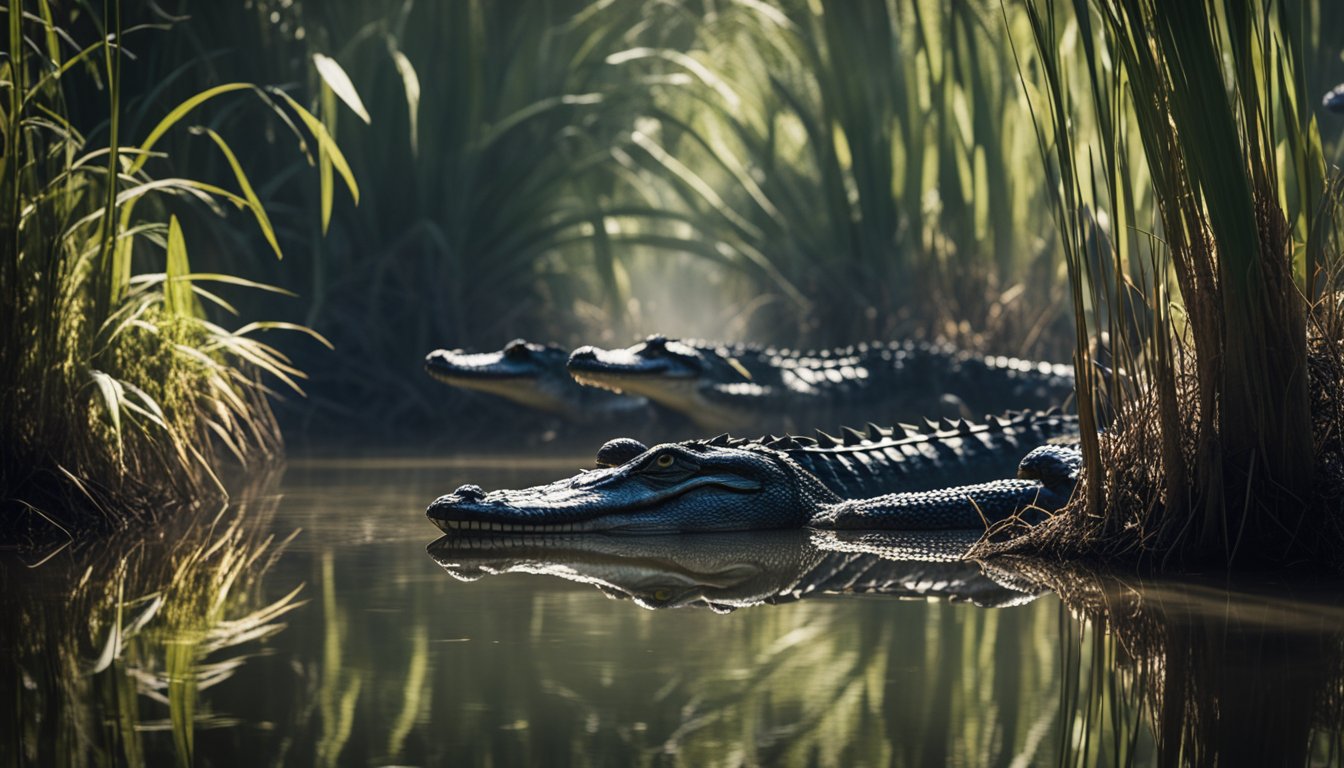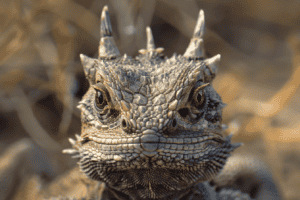Alligators are truly fascinating creatures, ancient reptiles that have been around for millions of years, yet they carry secrets that are just beginning to be understood.
Imagine stepping into a lush swamp, the air thick with humidity and the chorus of frogs and insects.
Then, you hear a low growl, and a pair of eyes surfaces above the water. That’s when you know you’ve entered alligator territory.

These incredible reptiles make their homes in the marshy waters of swamps and rivers, sliding through the murky depths with ease.
Alligators are known for their tough, armored skin and powerful jaws, but did you know they also display interesting behaviors that have intrigued scientists?
They can be seen basking in the sun to regulate their temperature or carefully guarding their nests where baby alligators wait to hatch.
As we unravel the swamp secrets of these amazing creatures, every fact can be a treasure unto itself.
Did you know that alligators can grow up to 15 feet in length and weigh over half a ton?
Or that they have a special valve in their throat that allows them to catch prey underwater without drowning?
Their world is a blend of brute strength, surprising tenderness, and intricate social behaviors that keep the ecosystem of their watery realms in balance.
Join us as we uncover the hidden life of alligators, their roles as predators, and how they continue to survive and thrive in their swampy domains.
Alligator Ancestry
Alligators have a fascinating lineage that stretches back to the age of dinosaurs.
They’re living fossils that have witnessed the Earth’s transformative history.
Prehistoric Predators
These impressive reptiles belong to the family Alligatoridae, and their ancient ancestors roamed the Earth over 200 million years ago during the Late Jurassic period.
Imagine, dinosaurs towering over the landscape while alligators patrolled the waters!
Fossil evidence suggests that these prehistoric alligator relatives, such as Deinosuchus, were even larger than the alligators we see today, with some measuring up to 33 feet long.
That’s as long as a school bus!
Evolutionary Journey
As you trace the evolutionary journey of alligators, you’d see they’ve been successful survivors, adapting to various environmental changes.
Their bodies have become streamlined for life in the water with webbed feet, muscular tails, and powerful jaws.
In fact, alligators and their close cousins, crocodiles, branched apart on the evolutionary tree around 80 million years ago, yet both still share many features from their ancient lineage.
Compared to their dinosaur contemporaries, alligators didn’t grow as much in size but perfected their survival skills to thrive in freshwater habitats.
This evolutionary expertise is why they’ve persisted when many other species have faded into history.
Swamp Ecosystems

Swamps are fascinating ecosystems, teeming with life and governed by the ebb and flow of water.
They serve as crucial habitats for a myriad of species, including the remarkable alligators, which are masters of their domain.
Let’s wade into the waters of swamp ecosystems and uncover the roles they play in the natural tapestry of our planet.
Alligator Habitats
The waterlogged world of swamps is a paradise for alligators, providing everything they need from shelter to sustenance.
In these wetlands, alligators find their home among the tangled roots of mangroves or the shadowy depths of slow-moving rivers.
With bodies perfectly adapted to their environment, they float almost invisibly, with only their eyes and nostrils breaking the water’s surface.
They select areas that balance their need for sunbathing spots—essential for regulating their body temperature—with the availability of prey like fish, turtles, and birds.
Swamp Biodiversity
Swamps burst with an incredible variety of life, serving as grocery stores, nurseries, and safe havens for countless organisms.
From the tiniest insects that buzz above the water to the elusive bobcat that prowls silently on the shore, swamps are hubs of biodiversity.
Each creature within the swamp has its role, whether it’s a bird that skims the water’s surface for insects or plants like cattails and water lilies which filter and oxygenate the water, maintaining the health of the ecosystem.
Did you know that swamps act as natural water filters? Yes, they help purify the water, which benefits everybody, including they themselves and humans!
Who knew that swamps could be so lively and important?
As one discovers the many creatures relying on the swamp, it’s hard not to admire this ecosystem’s intricate web of life.
Alligator Biology

Delving into the fascinating world of alligators, one will discover incredible adaptations that have allowed these creatures to thrive for millions of years.
From their unique physical attributes to the wondrous lifecycle, alligators are truly astounding reptiles.
Remarkable Reptilian Features
Imagine a creature with armor-like skin and the power to see in the dark! That’s an alligator for you.
Their tough, bumpy hide is actually a collection of bony plates called osteoderms or scutes, which serve as protection.
Within those dark pools of eyes, alligators possess a special layer called the tapetum lucidum, allowing them to see well at night while hunting.
Their snouts, broad and powerful, are not only formidable but surprisingly sensitive, detecting the slightest vibrations in the water.
What’s more, they sport an astounding 74 to 80 teeth at any given time and can regrow them as they wear down or lose them—a feat that adds to their fierce reputation.
The alligator’s tail warrants a special mention. Like a muscular oar, it propels them through water with great speed and agility.
On land, though not as swift as in water, their tail aids in balance and can deliver a powerful thump to deter potential threats.
Ever wondered how these reptiles manage to bellow so loudly?
It’s their strong muscular diaphragm, a rarity among reptiles, which helps them produce their notorious rumbling calls.
The Alligator Lifecycle
Picture this: a nest of alligator eggs, each one a potential predator waiting to emerge.
The lifecycle of an alligator begins humbly in a nest made of vegetation, which provides warmth as the decomposing plants generate heat.
Temperature plays a curious role here; it actually determines the sex of the hatchlings — warmer temperatures tend to produce males, while cooler conditions lead to females.
As they hatch, these tiny replicas of their parents utter high-pitched calls, which signal the mother to assist them in reaching the water.
Youthful alligators are called hatchlings and at this tender age, they’re vulnerable to a myriad of predators.
These hatchlings grow rapidly, feasting on insects, small fish, and even frogs.
Within two to three years, they’re usually safe from predators except for larger alligators and humans.
As they mature into fearsome adults, they graduate to larger prey like larger fish, birds, and even mammals.
On average, alligators have a lifespan of 35 to 50 years in the wild, and some have been reported to live beyond 70 years in captivity.
Throughout their lives, these apex predators play a critical role in their ecosystem, often referred to as “ecosystem engineers” because of their ability to modify their habitats.
Conservation and Threats

Alligators, those prehistoric-looking creatures that glide through the water with ease, face a range of threats, many due to human activities.
But fear not!
There are also incredible conservation efforts in place to ensure that these amazing swamp residents continue to thrive for generations to come.
Now, let’s take a closer look at the challenges they face and the strides we’re making to protect them.
Human Impacts
Humans have dramatically changed the landscape in which alligators live.
Wetland drainage and development for housing and agriculture have shrunk their natural habitat, leading to fewer places for alligators to call home.
Pollution is another culprit, muddying the once crystal-clear waters with contaminants that can harm alligator health and their ability to reproduce.
Illegal hunting poses a significant threat as well, despite the protective laws in place.
Alligators were hunted to near extinction in the past for their meat and hide, and it’s efforts on the part of concerned humans that have brought their populations back from the brink.
However, they are still at risk from poachers seeking to make a quick profit.
Conservation Efforts
The story isn’t all gloomy for these magnificent reptiles, thankfully.
Conservation efforts have made huge strides in bringing alligator populations back to stable levels. Alligators are now listed under the U.S.
Endangered Species Act, which provides them with a safety net against extinction.
Sanctuaries and protected wetlands offer safe havens where alligators can live without the threat of encroaching development.
Furthermore, research and monitoring programs give scientists vital information on alligator populations, health, and habitat use.
This information is critical in shaping effective conservation policies and in managing alligator populations sustainably, ensuring they remain an integral part of their ecosystem.
And did you know that alligators help their environment, too?
They create “gator holes” that provide wet habitats for other wildlife, proving that maintaining their populations is good for the whole swamp community.
Isn’t it fascinating how everyone is connected?
Frequently Asked Questions

Alligators are amazing creatures that have survived since the time of the dinosaurs.
Their world is full of fascinating secrets, from their hunting strategies to their incredible bite force.
In this section, we reveal the answers to some of the most commonly asked questions about these magnificent swamp dwellers.
What stealthy strategies do alligators use to catch their prey?
Alligators have mastered the art of the ambush.
Lurking just below the water’s surface, they wait patiently for an unsuspecting animal to come close.
With a lightning-fast lunge, they grip their prey with crushing jaws, showing that patience and the element of surprise are key in their hunting repertoire.
Can you explore the mysterious habitats of alligators found in swamps?
Swamps provide the perfect backdrop for an alligator’s lifestyle.
These wetlands are like underwater forests, where alligators can hide among the tangled roots and murky waters.
They swim through the swamps gracefully, using their powerful tails to propel themselves silently, ready to slide onto a sunny bank for a restful bask.
What are some jaw-dropping facts about the strength of an alligator’s bite?
An alligator’s bite is not only strong, it’s one of the most powerful of any living animal today.
They can slam their jaws shut with a force of over 2,125 pounds per square inch (psi).
That’s enough strength to break through tough turtle shells or crunch down on bones with ease.
Where can you watch the most captivating documentaries on alligators’ lives?
For an up-close look at alligators, one doesn’t need to trek to a swamp. Many wildlife documentaries have captured their lives in stunning detail.
Tune in to nature channels like National Geographic, BBC Earth, or streaming services that feature wildlife documentaries, and you’ll find a variety of captivating films that give an insight into their world.
How have alligators adapted to their environment over millions of years?
Over time, alligators have become expert survivors.
Their bodies have evolved to have a tough, armored skin that protects them from predators and the rough swamp environment.
They’ve also developed keen senses that enable them to detect the slightest ripples in the water, alerting them to potential meals or dangers.
What ranks alligators among the top ambush predators in the animal kingdom?
Alligators owe their top-tier status as ambush predators to both their physical traits and behavioral tactics.
Not only are they camouflaged and stealthy, but they also possess immense patience, lying in wait for the perfect moment to attack.
This combination of strength, stealth, and strategy place them among the most successful hunters in the swamps.









